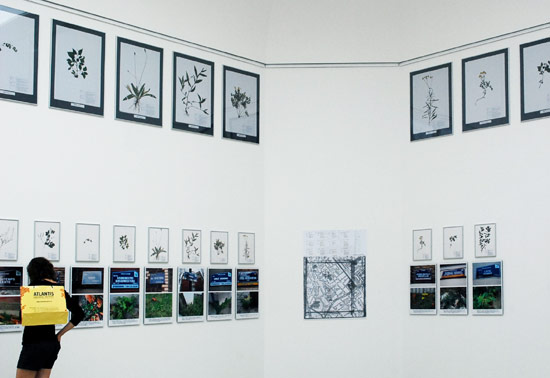Belgian Pavilion
53rd International Art Exhibition – La Biennale di Venezia
For La Biennale di Venezia, Jef Geys presents an entirely new project. Entitled "Quadra Medicinale", it is an interdisciplinary research project documented with plans, inventories, descriptions, photos and drawings.
As a point of departure, Jef Geys adopts the term 'terroir', a term that relates more to the notion of biotope than to territory. 'Quadra Medicinale' begins with basic research carried-out by four friends, one per city - Villeurbanne, New York, Moscow and Brussels, on request of the artist. In order to explore the basic elements within their immediate surroundings, each delineated one square kilometre and, within that area, searched for twelve wild plants growing in the streets. The result of this research is an inventory of ordinary plants, so-called 'weeds', which are very often edible or medicinal plants with special properties.
The presentation in the pavilion consists of different designations and scientific descriptions of the plants and their characteristics, a herbarium of dried specimens, and maps of the four cities noting the locations of the plants. The four series are accompanied by the artist's introductory text 'Quadra Medicinale', which appears in some twelve languages, printed in large format, each one annotated with handwritten translations of key words in the artist's development process. Thirdly, Jef Geys presents a series of 50 large drawings, graphical studies of different models; academic figurative studies in addition to plants and weeds, words and names, and pages out of military publications. The entire project is an analysis - by means of natural phenomena that are usually overlooked, an artist's statement complete with graphical renderings - on experience and language, on sources of knowledge as well as on aesthetic delight.
The project is accompanied by a special edition of the "Kempens Informatieblad" (Kempens Information Journal), which gives an overview of 53 of Jef Geys's projects dating from the late-1950s onwards. He documents his long-held interest in the relationships between 'low' forms and complex, 'sophisticated' disciplines such as science and art. In 1971, Geys took charge of the local journal, the Kempens Informatieblad. Since then he has made a special edition for each of his exhibitions. The intention here was to make an edible newspaper in order to test the cradle-to-cradle slogan 'Waste=Food", but the latest developments in printing technology do not yet enable this. The publication is also a guide for every person in need who tries to survive in a metropolis.
Jef Geys (born 1934; Leopoldsburg, BE) has summed up his entire oeuvre as an ongoing project that combines conceptual attitudes, educational activities, and formal experiments. In his practice, Geys affirms a radical independent position and develops an unprecedented approach to collective creativity, frequently generated by the participation of his immediate community. Much of his work has to do with the term 'terroir' (in the sense of biotope), using typical representations of everyday life.
Jef Geys's work has been exhibited worldwide at venues including: "Archive Fever", ICP, New York, USA (2008); "Deep Comedy", Marfa, Texas (2007); Orchard Gallery, New York, NY, USA (2007); IAC, Villeurbanne, France (2007); Pori Art Museum, Pori, Finland; Kunsthalle Lophem, Loppem (2005); Van Abbemuseum, Eindhoven, The Netherlands (2004); Documenta 11, Kassel, Germany (2002); Kunstverein, Munich, Germany (2001); Frac, Champagne-Ardenne, France (1995); Witte de With, Rotterdam, The Netherlands (1993); Palais des Beaux-Arts, Brussels, Belgium (1992); São Paulo Biennial, Brazil (1991).


















